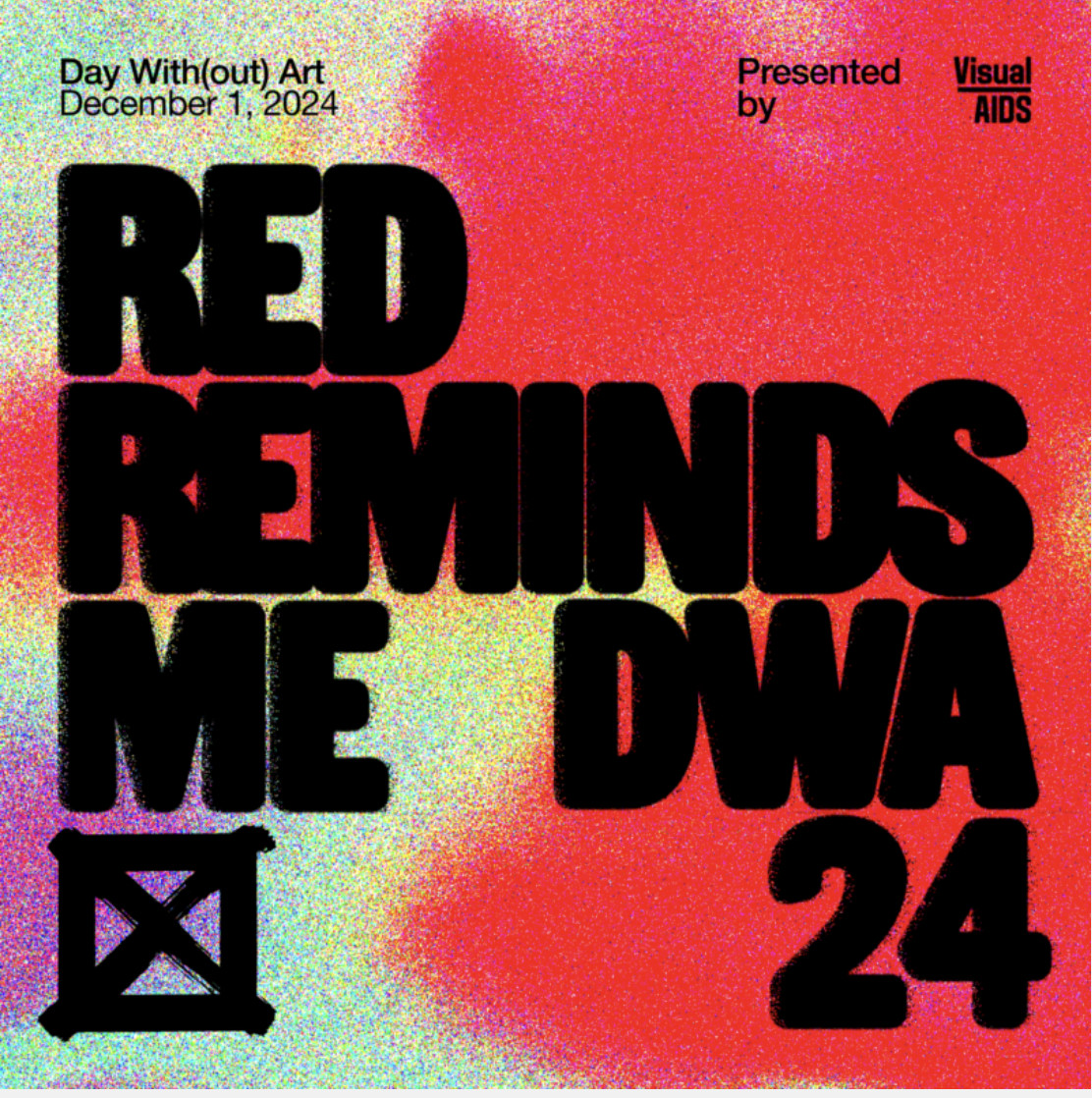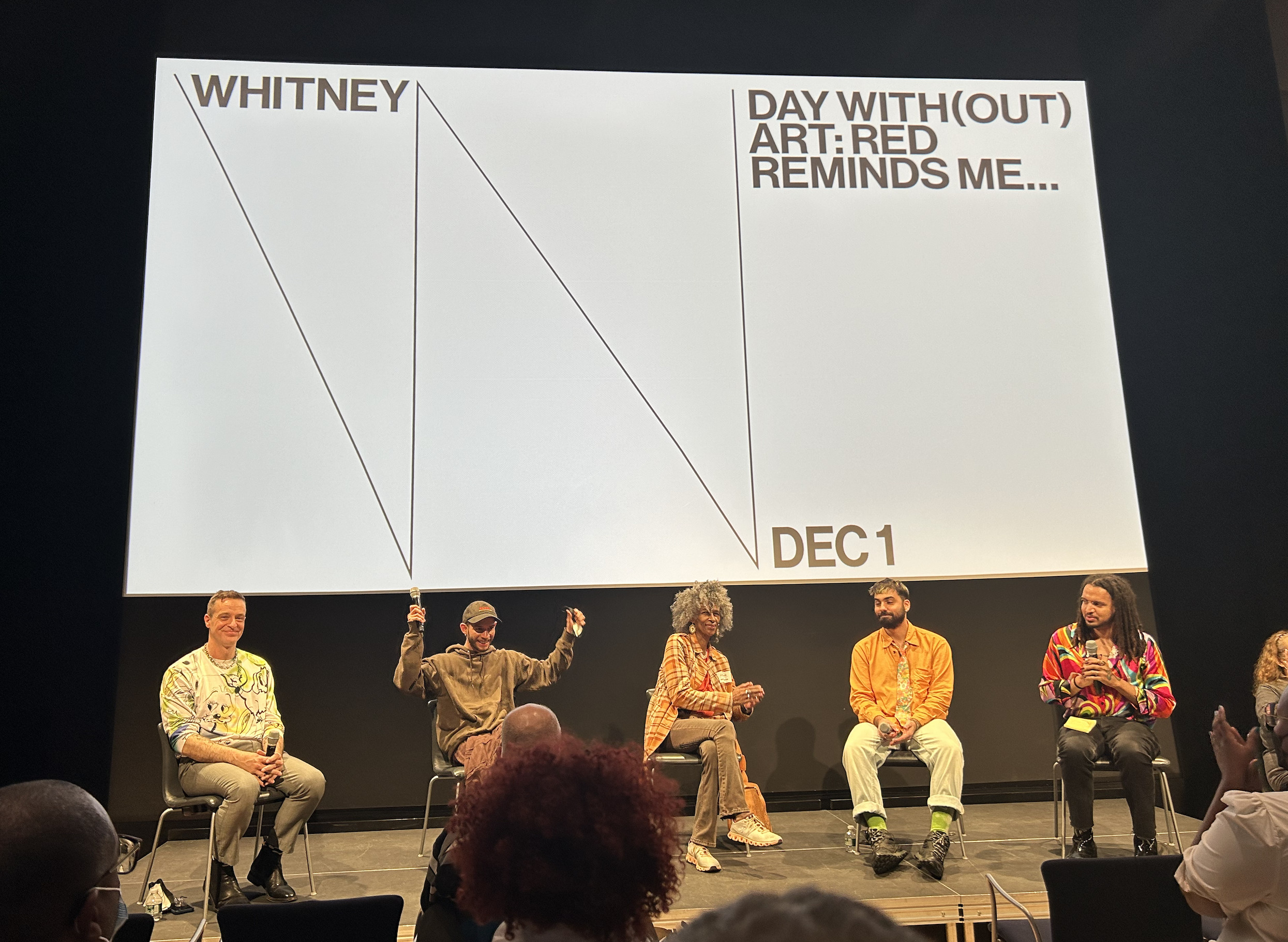Last night I had the pleasure of seeing the premier of Visual AIDS’ annual Day With(out) Art video program at the Whitney. Red Reminds Me … is playing this week at over 100 venues worldwide and is now available online (as is true for all of the commissioned video programs, starting with 2016’s Compulsive Practice, the program that I co-edited with Jean Carlomusto and Hugh Ryan). This year’s seven shorts reflect the emotional spectrum of living with HIV considering “a complex range of images and feelings surrounding HIV, from eroticism and intimacy, mothering and kinship, luck and chance, memory and haunting. The commissioned artists deploy parody, melodrama, theater, irony, and horror to build a new vocabulary for representing HIV today.”

Day With(out) Art is now 35 years old. Visual AIDS, the tiny and mighty contemporary arts organization that motors it, is one year older. See more about their work on this timeline.
This reanimated blog (a comparative newborn, only a week or so old in this application, but dating back to 2011)—querying how to live and learn in the interval between election and inauguration by joining audiences online and in-person—is well-informed by the efforts of the hardworking staff of Visual AIDS and their living and deceased artist members. What I learned from going and being in an event they have produced, tirelessly, for three and a half decades, is so simple it seems almost to go without saying.
An audience can be a community.

But under what conditions? And promoting what functions? As I experienced it last night, and indeed over all the yearly screenings I have attended since 2016, I suggest an audience is a community if it:
- comprises people who have done this work before, who are hailed, thanked, and included in the event even, and perhaps especially if, they are no longer alive. This is the subject of Imani Maryahm Harrington’s Realms Remix.
- verifies the lived experiences of people most affected and establishes how all are implicated. Drug addiction and isolation are so expressed by Vasilios Papapitsios in LUCID NIGHTMARE but then, Mariana Iacono and Juan De La Mar, establish how all can grow if we contribute to sexual justice and autonomy for women living with HIV in El VIH se enamoró de mi (HIV Fell in Love With Me).
- comprises the artists and the staff who support the effort. Here I give a shout out to Kyle Croft and Blake Paskal from Visual AIDS, and the staff from the Whitney (and the hundred+ participating organizations) who plan, set up, promote, contextualize, and then break down public programs. This little seen maintenance work allows the space to meet as well as frames with which to think and feel. (And here, I will humbly add the real work of the critic, whose labor puts that of artists into conversation with traditions of art, politics, and thinking, while documenting their efforts for future participants.)
- honors the work, pain, and joy of those who have lived, fought, and made art that invites us to make more, as does Gian Cruz, in Dear Kwong Chi his letter to the late artist Tseng Kwong Chi.
- returns across times of personal and movement wins and losses, grief and joy, power and retreat, as do David Oscar Harvey, in his essay film spanning his changing relations to HIV in Ambivalence: On HIV & Luck and Milko Delgado, in his El Club del SIDA, although in this case, over a signifcatly shorter time framework living with HIV. Hence:
- links diverse constituents (generationally, experientially, and otherwise) so as to accrue knowledge and feeling across difference. This is the project of Nixie, in it’s giving, where she explores notions of family across time, place, and gender.
- creates opportunities where participants are called together by named commitments that can be made more complicated, changed, acknowledged, connected, puzzled over, warmed, seen, shook-up, brought back, tended to or cared for. Really, all these and infinite other responses not motivated by consumption, fame, influence, or capital accrual. This is my acknowledgement of the art and activist crowd: the people you join, who you know and do not, who you might meet or might not. But, just experiencing time and place with them, those who also make the effort to be present in honor of a shared critique or affiliation affirms that you are not alone in your commitments.
- promises more. So, even when this discrete event ends, there are opportunities for participants to reengage, continue or build on what was learned or felt, anticipate the next iteration, or be so moved by the value of others’ labor (artists, organizers, fellow audience members) that one must do so oneself.
I have been an AIDS media activist and scholar, what fellow What Would an HIV Doula Do? collective member Jennifer Brier calls an “AIDS worker,” since I was 23. The audience I am describing last night coalesced around this commitment. But I am pretty sure that the conditions and functions that were so clear in this room, insuring that audience is community, can also occur with most any group (with contextual variations of course) who meets in persistent, movement-centered groups affirming the lived experience of the most affected, while learning from and connecting to history, and using the time we make together to feel, care, listen, and claim what is good, what is needed, and what we can aspire for even, or perhaps most importantly, in the most uncertain times.